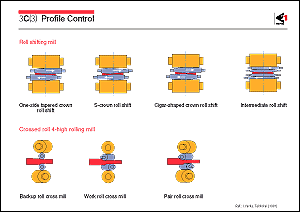Flatness failures include center
buckles and edge waves. With the former, the center of the width
is excessively elongated, resulting in waviness, while with the
latter, the edges of the strip are excessively elongated,resulting
again in waviness. Flatness failures and strip crowns are caused
by widthwise differences in the thickness reduction rate.
General methods for reducing strip crown include the 4-high rolling
mill, in which the work rolls are supported by back-up rolls;
the use of a roll crown, in which the work roll is given a convex
shape; and the use of the roll bender to deflect the roll in
the direction opposite that of the predicted strip crown. All
these methods have the following aims: Before entry of the strip
into the rolls, the work roll gap is arranged to have a concave
shape so that the center of the strip width is thinner than edges,
and after entry of the strip, the surfaces of the top and bottom
work rolls become parallel as a consequence of rolling. These
methods are in practical use, and strip crown has progressively
improved. New methods have also been developed for further improvements.
These include the roll-shifting mill, in which the rolls are
shifted in the widthwise direction, and the roll-cross mill,
in which the roll axes are crossed.
There are two types of roll-shifting mill. One shifts the work
rolls, and the other shifts the intermediate rolls. The work-roll
shifting type aims to make the strip thickness uniform and improve
the flatness over a wide range of strip widths by shifting rolls
of special shapes, as shown in the figure. The intermediate-roll
shifting type aims at greater efficiency in achieving the same
objectives by shifting the intermediate rolls so that their barrel
ends approach the edges of the material being rolled. In some
cases, a special shape is also given to the intermediate rolls.
In the roll-cross mill, the top and bottom roll axes are positioned
obliquely to each other to adjust the roll gap. A large effect
can be obtained with a crossing angle as small as 1.5 . The three types
of roll-cross mill are shown in the figure. The pair-roll-cross
mill is commonly used in hot rolling mills for plate and strip. . The three types
of roll-cross mill are shown in the figure. The pair-roll-cross
mill is commonly used in hot rolling mills for plate and strip. |
|
 |
 |
 |
|
|